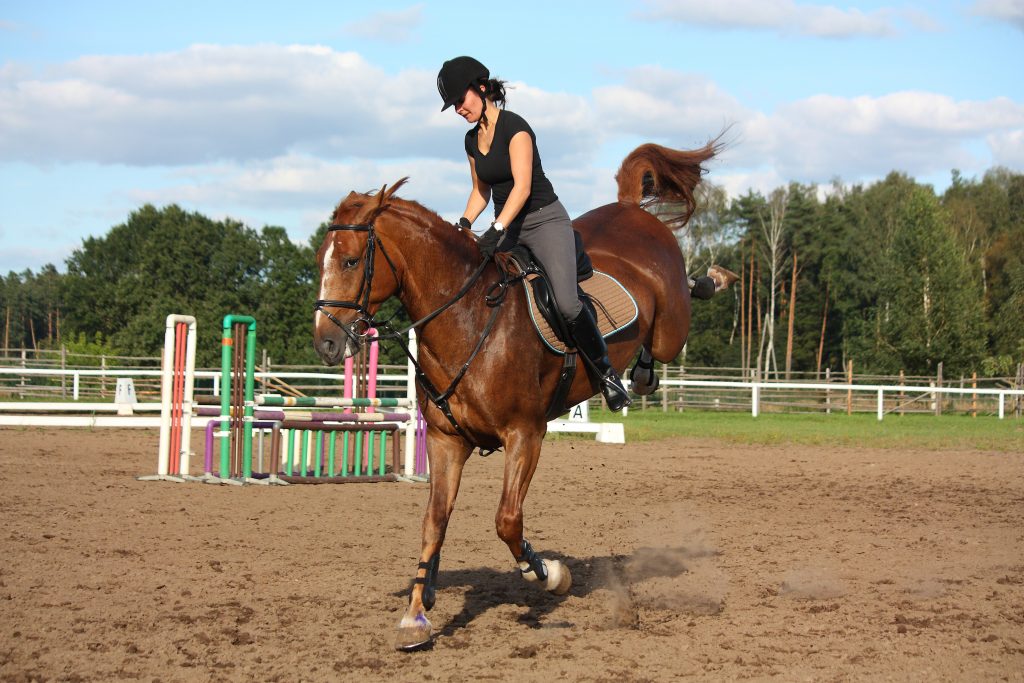Advice and Information
Treating Pain in Horses
By Dr Callum Macleod-Andrew, BSc BVSc MRCVS of Stride Equine Vets
Treating pain is a critical aspect of equine healthcare, aimed at improving the horse’s quality of life, promoting healing, and ensuring that the animal remains comfortable during injury, illness, or surgery. Horses can experience pain from various causes, including lameness, injuries, colic, dental issues, and chronic conditions like arthritis. Pain management in horses requires a comprehensive approach that combines medications, therapies, and good veterinary care.
Common Causes of Pain in Horses
- Musculoskeletal Injuries: Pain from sprains, strains, tendon injuries, or fractures.
- Lameness: Resulting from conditions such as laminitis or hoof abscesses.
- Colic: Abdominal pain caused by gastrointestinal issues, which can range from mild gas colic to severe intestinal blockages or volvulus/intestinal torsion (twisting of the gut).
- Post-Surgical Pain: Pain following surgical interventions, such as colic surgery or orthopaedic procedures.
- Dental Pain: Caused by sharp points, malocclusions, or infections in the teeth and gums.
- Chronic Conditions: Arthritis, degenerative joint disease, or other age-related conditions causing long-term discomfort.
Signs of Pain in Horses
Horses express pain in subtle ways, and owners and vets must be attuned to behavioural changes. Common signs of pain in horses include:
- Lameness or reluctance to move
- Weight shifting between legs or reluctance to bear weight on one leg
- Changes in posture (standing with an arched back or abnormal leg positioning)
- Loss of appetite or weight loss
- Restlessness or lying down more than usual
- Aggression or irritability when touched or worked with
- Grinding teeth or clenching the jaw (often seen in dental pain)
- Increased heart rate and respiration
- Flared nostrils and wide eyes (especially during severe colic pain)
Approaches to Pain Management
- Non-Steroidal Anti-Inflammatory Drugs (NSAIDs)
- Purpose: NSAIDs are the most commonly used drugs to manage pain and inflammation in horses. They work by reducing inflammation and lowering fever, which in turn alleviates pain and discomfort.
- Common NSAIDs:
- Phenylbutazone (Bute, Equipalazone, Chanazone, Butagram): Commonly used to treat musculoskeletal pain, lameness, and inflammation in cases like arthritis or tendonitis.
- Flunixin Meglumine (Finadyne): Often used to treat visceral pain, particularly colic, as well as fever and inflammation. This is a very potent pain killer used in the more painful cases, it is so powerful it can mask or hide serious conditions.
- Firocoxib (Equioxx): A COX-2 selective NSAID that is particularly useful for managing long-term pain in conditions like osteoarthritis while minimising gastrointestinal side effects.
- Considerations: Long-term or excessive use of NSAIDs can lead to side effects such as gastric ulcers, kidney damage, or colitis, so careful monitoring is essential; often the feeding of a probiotic alongside NSAIDs can help minimise these.
- Opioids
- Purpose: Opioids are potent pain relievers used primarily for more severe pain, such as post-surgical pain or in cases where other pain management options are inadequate.
- Common Opioids:
- Butorphanol: Often used in combination with sedatives for short-term pain management, particularly during medical procedures.
- Considerations: Opioids can cause side effects such as sedation, respiratory depression, or gastrointestinal disturbances, and their use in horses is generally limited to short-term situations under veterinary supervision.
- Local Anaesthetics
- Purpose: Local anaesthetics are used to block pain or sensation in a specific area of the horse’s body, providing targeted relief without affecting the whole system.
- Common Local Anaesthetics:
- Lidocaine and Bupivacaine: Often used during surgical procedures or nerve blocks to temporarily numb a region of the body, particularly in lameness exams or certain dental procedures.
- Applications: Local anaesthetics are commonly used in regional nerve blocks, such as in the case of foot lameness, or in epidurals for certain surgeries.
- Corticosteroids
- Purpose: Corticosteroids are potent anti-inflammatory drugs used to treat conditions involving severe inflammation, such as arthritis, joint pain, or chronic lameness.
- Common Corticosteroids:
- Dexamethasone
- Triamcinolone
- Uses: Corticosteroid injections into joints can provide long-term relief for conditions like arthritis, allowing the horse to remain comfortable and maintain mobility.
- Considerations: Long-term use of corticosteroids can lead to side effects, such as laminitis (especially in Cushings/EMS positive animals) or suppressed immune function, so their use must be carefully managed.
- Alternative and Complementary Therapies
- Purpose: These therapies can complement traditional medical treatments and help manage chronic pain or promote healing.
- Common Therapies:
- Acupuncture: Involves the insertion of fine needles into specific points on the horse’s body to relieve pain and improve overall well-being. Often used for musculoskeletal issues or chronic conditions.
- Chiropractic Care: Focuses on spinal alignment and musculoskeletal health to relieve pain, improve movement, and support recovery from injury.
- Massage Therapy: Aims to relieve muscle tension, improve circulation, and reduce discomfort from injuries or overuse.
- Cold Laser Therapy: Uses low-level laser light to stimulate healing and reduce inflammation in injured tissues.
- Regenerative Medicine
- Purpose: Regenerative therapies focus on healing damaged tissues and reducing inflammation, providing pain relief, and restoring function in cases of chronic or acute injury.
- Common Regenerative Therapies:
- Platelet-Rich Plasma (PRP): Involves injecting a concentrated solution of the horse’s own activated platelets into an injured area to promote healing, particularly for tendon or ligament injuries.
- Stem Cell Therapy: Uses stem cells derived from the horse’s own tissue to promote the regeneration of damaged cartilage, tendons, or ligaments.
- IRAP (Interleukin-1 Receptor Antagonist Protein): Injected into joints to reduce inflammation and pain associated with arthritis by blocking inflammatory pathways.
- Alpha-2-macroglobulin (A2M): A large protein found in the horse’s blood which is concentrated and injected into the joint. It breaks down inflammatory molecules in the joint similarly to IRAP but on a broader spectrum.
- All regenerative therapies are more protective of the cartilage within the joints.
- Nutritional Support and Supplements
- Purpose: Certain dietary supplements can help support joint health, reduce inflammation, and promote overall well-being, especially for horses with chronic conditions like arthritis.
- Common Supplements:
- Glucosamine and Chondroitin Sulphate: Support joint health by helping to maintain cartilage and reduce inflammation.
- Omega-3 Fatty Acids: Found in flaxseed or fish oil, these fatty acids have anti-inflammatory properties that may help reduce pain.
- MSM: Methylsulfonylmethane is a natural source of bio-available sulphur. Sulphur plays a key role in the production of collagen, which is a component of cartilage and connective tissue, so vital for joint health. It helps support the horse’s own natural anti-inflammatory and antioxidant processes.
- Hyaluronic Acid: Can help maintain joint fluid and reduce pain in arthritic horses.
- Environmental and Lifestyle Management
- Purpose: Adjusting a horse’s environment and activity level can help manage pain, especially in cases of chronic conditions like arthritis.
- Strategies:
- Turnout: Regular turnout and movement can reduce stiffness and pain, particularly in arthritic horses. Horses that are allowed to move naturally may experience less discomfort than those kept in stalls for long periods.
- Hoof Care: Proper hoof trimming and shoeing are essential for managing pain related to lameness. Specialized shoeing techniques, such as therapeutic shoes, can help alleviate pain caused by hoof or limb issues.
- Weight Management: Maintaining an appropriate body weight can reduce the strain on joints and limbs, decreasing pain associated with arthritis or other musculoskeletal conditions.


Pain Management in Specific Situations
- Colic Pain:
- Colic, which refers to abdominal pain, is a common and potentially life-threatening condition in horses. Flunixin Meglumine (Finadyne, Meflosyl) is often used to manage visceral pain during colic episodes, but if the pain is severe and unresponsive to medical management, surgery or euthanasia may be necessary.
- Post-Surgical Pain:
- Horses recovering from surgery may require a combination of NSAIDs and opioids for short-term pain relief, along with supportive care such as wound management and stall rest to aid in recovery.
- Dental Pain:
- Regular dental care can prevent dental pain caused by sharp points or infected teeth. In cases of severe dental pain, local anaesthetics or sedatives may be used to manage the discomfort during dental procedures.
Conclusion
Effective pain management in horses requires a tailored approach based on the underlying cause of pain, the horse’s overall health, and the intended outcome. A combination of medications, therapies, and environmental management can help horses remain comfortable, recover from injury, or live well with chronic conditions. Owners should work closely with their vets to monitor their horse’s pain levels and adjust treatment plans as necessary, always keeping the horse’s welfare and comfort in mind.

Call to ask any question
01420 551 365
Equine Services
Your Trusted Equine Partner
Expert veterinary care for horses in Surrey, Hampshire and the surrounding areas.

